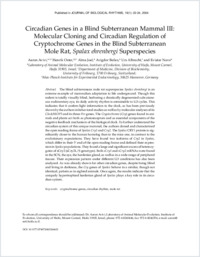Circadian Genes in a Blind Subterranean Mammal III: Molecular Cloning and Circadian Regulation of Cryptochrome Genes in the Blind Subterranean Mole Rat, Spalax Ehrenbergi Superspecies
- Avivi, Aaron Laboratory of Animal Molecular Evolution, Institute of Evolution, University of Haifa, Mount Carmel, Haifa, Israel
- Oster, Henrik Department of Medicine, Division of Biochemistry, University of Fribourg, Switzerland - Max-Planck-Institute for Experimental Endocrinology, Hannover, Germany
- Joel, Alma Laboratory of Animal Molecular Evolution, Institute of Evolution, University of Haifa, Mount Carmel, Haifa, Israel
- Beiles, Avigdor Laboratory of Animal Molecular Evolution, Institute of Evolution, University of Haifa, Mount Carmel, Haifa, Israel
- Albrecht, Urs Department of Medicine, Division of Biochemistry, University of Fribourg, Switzerland
- Nevo, Eviatar Laboratory of Animal Molecular Evolution, Institute of Evolution, University of Haifa, Mount Carmel, Haifa, Israel
-
2004
Published in:
- Journal of Biological Rhythms. - 2004, vol. 19, no. 1, p. 22-34
English
The blind subterranean mole rat superspecies Spalax ehrenbergi is an extreme example of mammalian adaptation to life underground. Though this rodent is totally visually blind, harboring a drastically degenerated subcutaneous rudimentary eye, its daily activity rhythm is entrainable to LD cycles. This indicates that it confers light information to the clock, as has been previously shown by the authors in behavioral studies as well as by molecular analyses of its Clock/MOP3 and its three Per genes. The Cryptochrome (Cry) genes found in animals and plants act both as photoreceptors and as essential components of the negative feedback mechanism of the biological clock. To further understand the circadian system of this unique mammal, the authors cloned and characterized the open reading frame of Spalax Cry1 and Cry2. The Spalax CRY1 protein is significantly closer to the human homolog than to the mice one, in contrast to the evolutionary expectations. They have found two isoforms of Cry2 in Spalax, which differ in their 5’ end of the open reading frame and defined their expression in Spalax populations. They found a large and significant excess of heterozygotes of sCry2 (sCry2L/S genotype). Both sCry1 and sCry2 mRNAs were found in the SCN, the eye, the harderian gland, as well as in a wide range of peripheral tissues. Their expression pattern under different LD conditions has also been analyzed. As was already shown for other circadian genes, despite being blind and living in darkness, the Cry genes of Spalax behave in a similar, though not identical, pattern as in sighted animals. Once again, the results indicate that the uniquely hypertrophied harderian gland of Spalax plays a key role in its circadian system.
- Faculty
- Faculté des sciences et de médecine
- Department
- Département de Biologie
- Language
-
- English
- Classification
- Biological sciences
- Other electronic version
- License
- License undefined
- Identifiers
-
- RERO DOC 4327
- Persistent URL
- https://folia.unifr.ch/unifr/documents/299726
Statistics
Document views: 59
File downloads:
- 1_albrecht_cgb.pdf: 206
